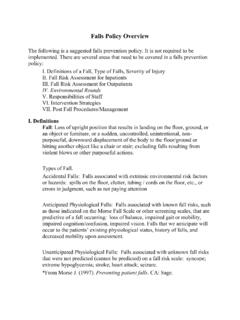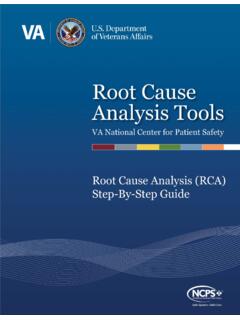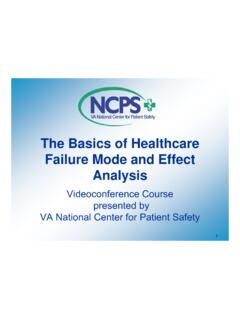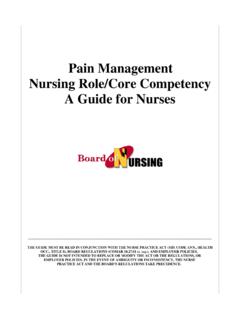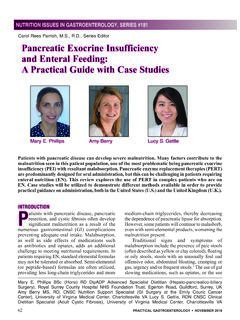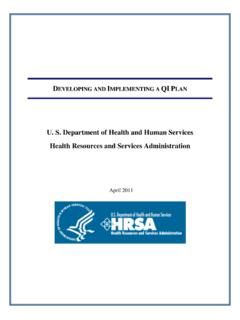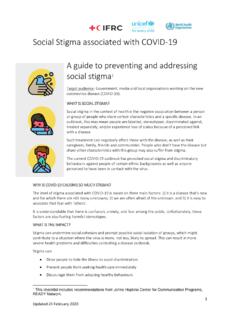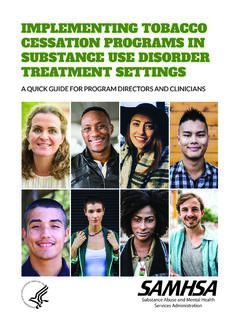Transcription of Guide to Performing a Root Cause Analysis (Revision …
1 1 Guide to Performing a root Cause Analysis (Revision 02/05/2021) Published by VHA National Center for Patient Safety (NCPS) 2 Table of Contents Introduction .. 4 Purpose of the Guidebook .. 4 Determining when a root Cause Analysis is Required .. 5 Characteristics of a root Cause Analysis .. 5 root Cause Analysis Flow 6 Steps to Completing a root Cause Analysis .. 7 Step 1: Charter a Team .. 7 Step 2: Conduct Just in Time Training .. 8 Step 3: Create the Initial Flow Diagram .. 9 Step 4: Craft the Initial Understanding .. 10 Step 5: Identify Information Gaps .. 11 Step 6: Use Triage Questions .. 11 Step 7: Collect Resources and Prepare for Interviews .. 12 Step 8: Conduct the Safety Investigation .. 12 Step 9: Create the Final Flow Diagram .. 13 Step 10: Create the Cause and Effect Diagram .. 15 Step 11: Craft the Final Understanding .. 19 Step 12: Identify and Craft root Cause and Contributing Factor Statements.
2 19 Step 13: Develop Action Statements .. 22 Step 14: Develop Outcome Measure Statements .. 24 Step 15: Provide Feedback .. 25 Step 16: Identify Lessons Learned .. 26 Step 17: Prepare and Present Findings to Leadership .. 26 Upon Completion of the root Cause 27 Monitor Actions and Outcome Measures .. 27 Communicate Improvements to Staff .. 28 Calculate the Cost .. 28 RCA Analysis .. 28 Appendix A: Glossary .. 31 3 Appendix B: Example root Cause Analysis .. 33 Appendix C: Aggregated Review RCAs .. 40 Appendix D: Quiz Questions .. 43 Appendix E: Quiz Answers .. 48 References .. 51 4 Introduction Patient safety events can Cause serious harm or death. To address and prevent these threats, health care organizations must unearth the root causes and develop solutions that address the problems from a systems perspective. Despite advances in health care, the occurrence of failures persists.
3 When failures reach the patient, the results may include tragedy for patients and their families, costs to an already overburdened health care system, adverse public perception of an organization, and litigation. They can also deeply affect health care professionals who are dedicated to the well-being of their patients . Most failures are the result of system and process flaws. These flaws are often not immediately apparent and require investigation or systematic Analysis . The most commonly used comprehensive systematic Analysis is the root Cause Analysis (RCA). The RCA is a process for identifying the basic causal factor(s) underlying system failures and is a widely understood methodology used in many industries. root Cause Analysis can be used to uncover factors that lead to patient safety events and move organizations to deliver safer care. Its uptake in healthcare has allowed for more accurate and rapid assessment of potential and actual causes of patient harm.
4 The RCA process builds local and national knowledge about system vulnerabilities and helps increase the speed by which patient safety improvements occur throughout the system. Increasingly, health care organizations are using this methodology to investigate close calls, no-harm patient safety events, and other signals of risk. Health care organizations no longer have to wait until after a sentinel event occurs to perform a root Cause Analysis . When an adverse outcome, a sentinel event, or a cluster of less serious incidents or near misses occurs, organizations must develop an understanding of the contributing factors and the interrelationship of those factors. The organization must then implement an action plan to fortify its systems against vulnerabilities with the potential to impact patients . Purpose of the Guidebook The purpose of this guidebook is to describe how to complete an RCA according to protocol established by the Veteran Health Administration (VHA) Patient Safety Program and VHA Patient Safety Handbook Intended users of this guidebook include patient safety managers or any persons who may lead, facilitate, or participate in RCAs.
5 Definitions for key terms in the guidebook can be found in the Glossary (Appendix A). Upon review of the guidebook, the user will understand each step associated with the VHA s RCA process, as well as the employment of the RCA Quality Analysis Tool (QAT). A quality RCA example may be found in Appendix B. While the steps outlined below are specific to completing individual RCAs, Appendix C describes the similarities and differences that are important when completing Aggregated Review RCAs. Finally, upon review of the guidebook, users may test their knowledge by answering relevant quiz questions in Appendix D. The answers and supporting rationales are in Appendix E. 5 Determining when a root Cause Analysis is Required RCAs are required for any sentinel event, serious safety event, or for any patient safety event that poses a substantial, direct, and high probability that a serious safety event would have occurred but did not occur due to intervention or chance.
6 These events are given a safety assessment code (SAC) of Actual 3 or Potential 3. Because of their high frequency, some events receiving a Potential 3 SAC do not require an individual RCA and should either be aggregated and analyzed together, such as in the annual Medication Aggregated Review RCA, or reviewed for inclusion in a patient safety assessment tool (PSAT), such as the annual Wandering and Missing Patient PSAT. Events falling into these aggregated or PSAT reviews may also receive an individual RCA at the discretion of the facility. SAC 1 or 2 events can be evaluated through the use of an individual or an Aggregated Review RCA, depending on the topic and the needs of the facility. All RCAs must be formally chartered and signed by the facility Director. Appendix C describes steps for completion of Aggregated Review RCAs. Characteristics of a root Cause Analysis RCAs should adhere to the procedures provided in this document, including the initiation of an RCA with a written charter memorandum.
7 All RCA documents, including the QAT, must have the term root Cause Analysis written on them so that they are protected and deemed confidential under 38 5705 and the implementing regulations (VHA Directive 2008-077, Quality Management (QM) and Patient Safety Activities that Can Generate Confidential Documents). Email correspondences are not protected. An RCA is not protected unless the RCA charter memorandum is signed by the facility Director or designee. RCAs must be completed, signed by the facility Director, and documented in SPOT within 45 calendar days of the facility becoming aware that an RCA is required. An RCA is interdisciplinary in nature, identifies system vulnerabilities of risks and their potential contributions to the adverse event or close call, and identifies changes that can be made in systems to improve performance and reduce the risk of event recurrence. Figure 1 provides a graphic presentation of the process steps for completion of an RCA.
8 Following the Figure, the guidebook will iterate crucial steps in the process to more fully describe key information essential for success. 6 root Cause Analysis Flow Diagram Figure 1. RCA Process Steps 7 Steps to Completing a root Cause Analysis Step 1: Charter a Team Team composition should be between four and six members. This is founded in the rationale that the team needs to be large enough to allow diverse viewpoints and opinions (avoiding groupthink ), but small enough so that meetings do not become unwieldy or work deadlines cannot be accomplished. The membership should include: Leader An individual who is well versed in the RCA process and has the requisite knowledge required to keep the team on track and aligned with the required components of adverse event investigations. The leader also organizes meetings, assigns roles and ensures that deadlines are met. Advisor An individual with expertise in the RCA process and the various milestone associated with each phase of the team s work, flow diagrams, interviewing, simulation, Cause and effect diagramming, final understanding, root / Cause contributing factor statement development, action planning, outcome measures and communicating findings to leadership for concurrence.
9 The advisor is not normally present for all meetings but is available as needed to assist the team. Subject Matter Expert (SME) An individual possessing intimate familiarity with the area, domain, clinical discipline, processes and topic being investigated. The SME is often a front-line staff member who is not directly involved in the event. Non-SME An individual unfamiliar with (na ve to) the specific area, processes, or discipline involved in the adverse event or close call. The charter should, at a minimum, describe the professional title of the individual and their specific role on the RCA team. Individual names can also be provided in the charter memorandum. The following represents an example depiction of team membership. 1. Director of Biomedical Engineering SME 2. Staff Nurse Medicine SME 3. Administrative Clerk Business Office Non-SME 4. Physician Intensivist SME Leader 5. Respiratory Therapist Team Member Recorder 6.
10 Patient Safety Specialist Team Member Advisor 8 Step 2: Conduct Just in Time Training Training conducted during the initial RCA team meeting is especially important for new RCA team members and should be completed with every RCA even if there are no members new to the RCA process. NCPS has created a Just in Time training video that may be shown at the beginning of each RCA to ensure all team members have a baseline knowledge of the process: Just in Time Training Video Having a senior leader greet the RCA team is recommended. This serves to provide tangible executive leadership support for the RCA team. The senior leader should validate the importance of the work ahead and communicate the executive leadership s team commitment to the process. Just in Time training should provide an overview of the RCA process that includes the following information: Confidentiality. Any documents or records, which result from this RCA, are confidential and privileged under the provisions of 38 5705 and its implementing regulations.


